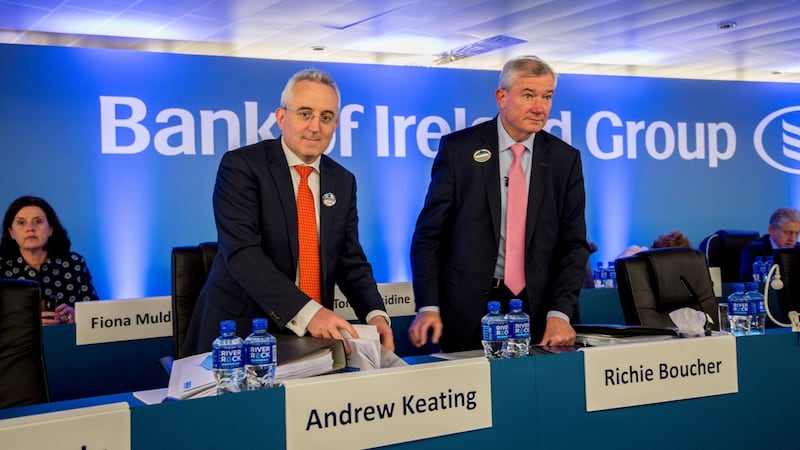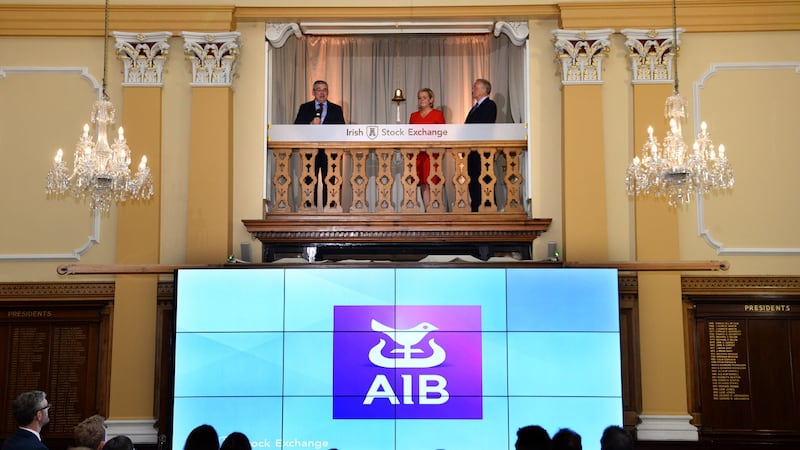For followers of Irish banks, an all-too-familiar – and increasingly powerful – bogeyman continues to lurk in the shadows.
Permanent TSB's chief executive Jeremy Masding said this week that the European Central Bank is likely to stand in the way of the group hitting its target of returning to paying dividends in early 2019 for the first time in over a decade. That's because non-performing loans (NPLs) continue make up 28 per cent of its total portfolio – the highest among the Republic's banks.
The dividend target now looks “very ambitious”, said Masding. “Does it have a high probability? No. Until we make progress on the untreated NPLs, I think it’s going to be very difficult for us to have a conversation [with regulators].”


The spectre of the ECB has loomed large over the Irish financial and political landscape in the past decade. The Frankfurt institution – which gave Irish lenders tens of millions of euro in emergency funding as depositors fled during the crisis – pressed the Republic to take an international bailout in 2010 and blocked efforts by the Government to share banks’ bad-loan losses with senior bondholders.
Since then, the ECB has been empowered even further, with its new banking supervision arm set up in 2014 to centralise the regulation of euro-zone lenders.
In the past six months, the ECB’s banking division, the Single Supervisory Mechanism, has upped the pressure on lenders across the single currency region with high levels of non-performing loans. While Irish banks have slashed their problem loans ratio from an average of 27 per cent in 2013 to 14.2 per cent at the end of last year, they remain well above the 5.4 per cent EU average – leaving them firmly in the ECB’s cross hairs.
"Scrutiny from the ECB on the progress in dealing with NPLs remains a key risk for all European banks with significant levels of problem lending," said Owen Callan, an analyst with Cantor Fitzgerald in Dublin. "This was seen most acutely with Permanent TSB this week."
Repayments
But there are good non-performing loans and there are bad non-performing loans, as Masding pointed out on Wednesday.
More than half of the bank’s €5.78 billion of non-performing loans have been restructured, with more than 90 per cent of these performing in line with their new terms.
Many of these loans – such as split mortgages, where repayments on a portion of the original facility are frozen for an extended period – will remain in the impaired basket for years, until borrowers are actually paying down the warehoused amount.
However, these “treated” loans are paying up cash, equivalent to 3.6 per cent of the amount outstanding. This makes them a valuable asset and important contributor to the bank’s profits.
The real problem for PTSB is its €2.68 billion portfolio of “untreated” non-performing loans – where borrowers’ circumstances are either so dire the bank can’t offer them a workable solution or the borrower has refused to engage.
The bank has now decided to call time on these borrowers, which it wants to banish from its balance sheet over the next three to five years.
“For that [portfolio] we’ll try and encourage the system to broaden access to mortgage-to-rent as much as we can, assisted voluntary sales, loan sales and, as a last resort, foreclosure,” said Masding.
“The main concern for PTSB is that, while there’s external pressure on all Irish banks to cut their non-performing loan ratios, its high level stands out. With loan sales now on the agenda, their backs are against the wall,” said a Dublin-based analyst, who declined to be named.
“While the bank has set aside provisions of about 50 per cent against its impaired loans, the big concern is that would-be buyers, or what some people call vulture funds, will come in with offers of, say, 40 cent on the euro for portfolios, resulting in a capital hit and follow-on impact on dividends.”
Significant discounts
Investec’s Callan said there is an “increasing probability of PTSB management now needing to dispose of bad loans at significant discounts to book value, which has significantly impacted on the investment case for the bank and the previous potential for excess capital to be returned to shareholders”.
PTSB's level of NPLs have been exacerbated by the fact that the bank was forced to sell its largely-performing UK mortgage portfolio in the past two years, under the terms of its European Union restructuring plan, following its taxpayer bailout.
The analyst said real pressure will be brought to bear on resolving the “untreated NPLs” issue over the next 18 months, before the ECB is expected to start to increase interest rates again. The bank’s benchmark rate is currently zero, having fallen from 4.25 per cent at the onset of the crisis in 2008.
While AIB once had by far the highest level of soured loans among Irish banks that survived the crisis, the ECB gave it permission earlier this year to pay its first dividend since 2008. The Government, then owned 99.8 per cent of the bank at the time, received most of the €250 million payment.
A central part of the investment case for AIB as it returned to the main markets in Dublin and London last month for the first time since it was effectively nationalised in late 2010 is the prospect of the bank becoming a dependable payer of dividends.
"We expect to have a progressive dividend policy," AIB chief executive Bernard Byrne said in a phone interview with The Irish Times on Thursday, after the group unveiled a 12 per cent increase in operating profit for the first half of the year to €814 million – a figure flattered by the fact that it has raised the value of some big company loans that had been restructured following the crisis.
While AIB’s impaired loans have fallen from a peak of €29 billion in 2013 to €7.8 billion in June – including a €1.3 billion reduction in the past six months – the level remains above 12 per cent that of the bank’s gross loan book. The bank aims to reduce the level to between €3 billion and €4 billion by the end of 2019, with ongoing restructuring aided by portfolio sales and what it calls “strategic initiatives”.
Special purpose vehicles
The Irish Times reported last month that banks are considering ways other than outright sales to shift loans off their balance sheets. These include setting up special purpose vehicles that would house bundles of non-performing loans, according to sources. The banks would need to sell a majority stake in such vehicles to outside investors to reclassify the loans as no longer being on their books.
Similarly, some lenders are also weighing the possibility of bundling portfolios of mainly non-performing mortgages and selling bonds in capital markets, secured by the assets. Lone Star and Oaktree affiliate Mars Capital have moved in the past eight months to refinance hundreds of millions of euro worth of mainly soured loans bought from lenders in recent years through such so-called residential mortgage backed securitisation (RMBS) deals.
The banks would have to set up any potential RMBS transactions off-balance sheet to be able to remove the assets from their accounts.
PTSB’s Masding highlighted on Wednesday that the bank was considering “financial engineering” initiatives to help lower the bank’s non-performing loans ratio, but declined to give specifics.
While analysts reassess their calculations over whether PTSB will have “excess” capital at the end of the day that can be returned to investors, Masding is confident.
The PTSB investment case for investors is based around building a successful retail and small-business bank, as well as the bank’s restructured loans, which will allow for bad loan provisions to be released over time.
“We need to persuade investors that that’s an annuity stream,” Masding said, referring to the possibility of provision write-backs. “I genuinely believe that there’s an annuity stream.”
Investors who bought into AIB’s initial public offering last month, in which the State sold a 28.8 per cent stake in the bank for €3.4 billion, appear more convinced about “excess” capital in the bank coming back to shareholders.
Investment firm Cantor Fitzgerald estimates that the bank is likely to pay €1.24 billion in dividends up until the end of 2019, but will still have €3.35 billion of surplus cash on its balance sheet.
However, analyst Stephen Hall has said the bank would likely need to show further meaningful progress to the ECB on non-performing loan reduction before it will get the go-ahead to hand out surplus money to shareholders.
Meanwhile, all eyes are on Bank of Ireland, which reports first-half figures on Friday, after the bank decided in February to delay its return to paying a dividend by a further year, due to the vulnerability of its pension scheme to volatility in bond markets.
Expectations
The deficit in the bank’s defined benefit schemes, where pension payments are linked to retirees’ final salaries, doubled in the first nine months of last year to €1.45 billion, before falling by half in the final quarter as bond yields soared, driven by inflation and rate hike expectations in the wake of Donald Trump’s election as US president.
Deutsche Bank analyst David Lock said in a recent note to clients that, while the bank's pension gap widened by €200 million to €650 million in the first three months of the year, it is likely to have narrowed again in the second quarter. This is down to a rebound in corporate bond yields, which companies use as a discount rate to value pension schemes, in the past three months, he said.
However, followers of Bank of Ireland will also be keeping an ear out for any comments bank makes about the ECB’s targeted review of how euro zone lenders calculate risk on their loan books.
PTSB warned this week it is likely to have to recognise effectively about €2.8 billion of additional so-called risk-weighted assets as a result of the ongoing review. The effect of this will serve to knock about four percentage points off the bank’s all-important reserve ratios.
AIB declined to give such detail on Thursday, with chief financial officer Mark Bourke merely saying that the ECB-led review and impact of proposed new banking regulations will probably exert "upward pressure" on its risk-weight assets, though this should fall again over time.
PTSB's new chief financial officer Eamonn Crowley said that, as Irish banks are likely to be forced by the ECB to recognise higher levels of risk-weighted assets than elsewhere, given the scale of the recent crisis in this State, there may be need for a wider "Ireland debate" to resist any such move.
Few doubt who will win that one.












